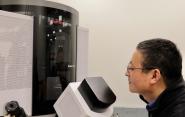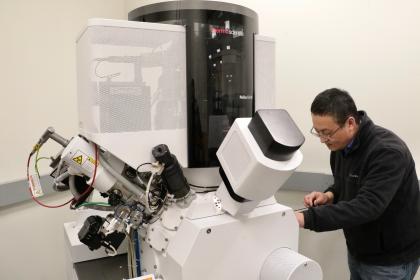Focused Ion Beam Arrives, Gives Researchers New Possibilities

To prepare their samples for transmission electron microscopy (TEM) characterization, Judy Cha and her research team go to New York, where they use a focused ion beam (FIB), which essentially acts as a scalpel that cuts with nanometer-scale precision. The frequent trips are inconvenient and take a long time, but they’re essential to Cha’s work.
Fortunately for Cha and many other researchers, Yale has just acquired its own FIB at West Campus.
 “Because most of our materials are nanoscale, TEM studies to characterize the atomic structure is important, and FIB is a primary tool to prepare TEM samples,” said Cha, the Carol and Douglas Melamed Assistant Professor of Mechanical Engineering & Materials Science. “Having an FIB adjacent to the Energy Sciences Institute (ESI) will accelerate our research.”
“Because most of our materials are nanoscale, TEM studies to characterize the atomic structure is important, and FIB is a primary tool to prepare TEM samples,” said Cha, the Carol and Douglas Melamed Assistant Professor of Mechanical Engineering & Materials Science. “Having an FIB adjacent to the Energy Sciences Institute (ESI) will accelerate our research.”
In addition to preparing TEM samples, other uses for the machine include e-beam lithography, electron backscatter diffraction(EBSD) and obtaining 3D slices of samples with energy dispersive X-ray spectroscopy (EDS).
Min Li, a research support specialist at West Campus, said the FIB – a state-of-the-art FEI Helios G4 UX - will be useful to a wide range of researchers, including the ESI, the Institute for the Preservation and Cultural Heritage (IPCH) and numerous faculty members in biomedical engineering, chemical and environmental engineering, and mechanical engineering & materials science.
“It’s big boost for research in the materials area at Yale,” he said.
Among other uses, the FIB can be used to create patterns at the microscale and even at the nanoscale. For instance, a user can create nano-sized trenches - straight or curved - on a piece of silicon or platinum.
Li said the FIB will be useful for making microfluidic devices. Many of these involve tiny channels that allow fluids to pass through as a way to mimic the mechanics of the human body. Because these devices require patterns that are so small and precise, Li said, developing them would be impossible without an FIB.
Technicians spent much of January installing the machine and will be testing it this month with the help of potential users. Li said it’s a complex machine and it will take some time to get users up to speed on how to operate it. Cha said the effort will be worth it, as it will means that her exhausted graduate students won’t have to make the trek to New York for TEM samples anymore.

